First step: avoidance
In planning a project or action, first start by seeing how you can avoid creating negative impacts.

Youth is one of critical groups to whom it is crucial to achieve the Paris Agreement’s goals.
This is why YEE has developed its advocacy strategy towards COP27, while preparing for its representation at the UN Climate Change Conference.
The first section will introduce COP27 and highlight its global and regional relevance;
The second section explains YEE’s main objectives and lays down a set of overarching themes, which essentially make up the backbone of YEE’s Youth policy position related to the climate crisis.
The third section of this Policy Brief focuses on the key topics of COP27, including YEE’s research topics, and explores existing challenges and recommendations to most effectively address them under the scope of UN climate change negotiations and from a youth-based viewpoint.
Lastly, there is a set of conclusions ultimately representing YEE’s key messages in the context of COP27 youth-led advocacy.
Learn more about YEE at COP27
How do we manage environmental harm? All parts of society have an environmental impact, be it on our climate or biodiversity. Footprint compensation is one of the main policy tools used to mitigate this harm but it is also at the core of a heated debate. Let’s look into it! Author: Chloé ten Brink The first step in addressing the issue of environmental harm is figuring out how to measure it. The concept of footprints was developed by scholars Wackernagel and Rees in the 1990s to do just that. Footprint, particularly the carbon footprint, is a term we hear very often and has become incredibly popular in the media as it provides a quantifiable understanding of ecological harm. The ecological footprint measures the use of land and other environmental resources needed for a given action, and therefore its impact. Within the wider ‘footprint family’, you have more specific calculations such as the climate (or carbon) footprint and biodiversity footprint. The carbon footprint is measured in metric tonnes of C02 and the biodiversity footprint is measured in global hectares, relative to the pressure exerted on land and ecosystems (although there is more than one way to measure this, given how many factors are involved in biodiversity harm). Once we’ve measured our problem, one would hope we would want to do something about it – to compensate for the damage we have done. That’s where offsetting comes in! This definition from the Institute for European Environmental Policy (IEEP) is useful: offsetting is the “measures taken to compensate for any residual significant, adverse impacts that cannot be avoided, minimised and/or rehabilitated or restored, in order to achieve no net loss or a net gain of biodiversity.” These measures typically include paying for various projects which reduce the harm done: to offset a carbon footprint, carbon sequestration projects are usually funded (such as the typical tree-planting!), whereas to offset a biodiversity loss, restoration and conservation projects are funded. This whole approach to minimising harm is an application of the “polluter pays” principle – those who made the mess should be the ones to clean it up. While these concepts are fairly widely discussed and used nowadays, they are the product of a lot of policy deliberation. The second half of the 20th century, especially in the US, favoured market mechanisms rather than command-and-control policies to deal with environmental issues. Policies such as offsetting utilise these market mechanisms: you pay for your actions. In this political climate, George Bush Senior, during his political campaign, attempted to promote the idea that economics and environmental issues could work together and use the same type of thinking. In the specific context of protecting wetlands, he promoted the term No Net Loss: the idea that “damages resulting from human activities need to be balanced by at least equivalent gains.” It brought together the idea that economic development, when paired with a compensation project or payment, would see no overall detriment to our environment. One of the first applications of this principle occurred in 1988 when Applied Energy Services built a coal-fired power plant in Connecticut that would produce 14.1 million tons of carbon over the project’s 40-year lifespan. Through consulting with the World Resources Institute, they funded a forestry project in Guatemala. This was well-received at the time and opened the door to the idea of offsetting in practice. This notion of offsetting and trading your negative actions for an alternative positive action has grown and spawned other ideas such as carbon credits and emissions trading. In 1995, the Kyoto Protocol brought about the notion of international emissions trading – a system which allows countries that have emissions units to “spare” (or rather emissions that they are permitted to but have not used) can be sold to countries that are over their targets. Also known as credits, it’s an application of the idea of bargaining and compensation. The world’s first international emissions trading system occurred in 2005 with the EU Emissions Trading Scheme. Now that we have a little background on the definitions and history behind the idea of footprint offsetting we can look at them a little more critically: Carbon compensation is an extremely debated topic and it is often chalked up to a form of greenwashing. First of all, simply the means of measuring climate harm through the carbon footprint has a tricky history. A term developed by scientists but popularised infamously by British Petroleum in a very successful campaign which essentially placed the responsibility for carbon emissions on the consumer rather than the producer (them). The carbon footprint asks difficult questions about responsibility but so does the idea of offsetting, which has often been called a method to “burn now, pay later”. It is a policy approach which doesn’t compel actors to reduce how much carbon dioxide they emit by giving them an “easy way out”. Nonetheless, this is now a huge market. There is a mandatory carbon market through policies such as the European Emissions Trading System and a voluntary one, in which companies and individuals choose to buy carbon offsets. Both of these markets together were valued at over 262 Billion US Dollars in 2021. And yet – despite this market seeming very big – it’s not quite sufficient. We emit more carbon than can be compensated. Only about 0.8-1% of annual CO2 emissions are offset. And even if we utilised all the projects that are currently available as carbon offsetting techniques, only about 1.6-1.75% of carbon emissions would be offset. It will never be enough to reach carbon neutrality globally – and often the projects used to “offset” carbon don’t even directly aim at carbon sequestration but generally fund environmental projects. Biodiversity offsetting has its own set of specific limitations and issues. Firstly measuring biodiversity harm is difficult and there are different forms of damage: destroying or polluting a habitat, or harming a given species etc. And in some cases, the damage is too great – for example, the disappearance of an endangered species. Moreover, damage to one habitat or ecosystem can’t be compensated by improvement to another ecosystem – it’s sort of like apologising for your child’s broken bone by curing their siblings’ flu. It does overall good for your family but it doesn’t fix the original issue. So how can we go beyond just seeing their limitations? A useful tool for thinking about offsetting’s role in environmental mitigation is the mitigation hierarchy which allows us to view offsets as a “last resort”. It allows us to think about managing environmental harm in various steps:A critical look at footprint compensation
What is footprint compensation, and how is it different for climate and biodiversity?
A little history – the evolution of the notion of footprints and compensation
Comparing footprint compensation limitations for Climate vs. Biodiversity
Climate compensation, the carbon footprint & limitations
Biodiversity footprint compensation & limitations
The Mitigation Hierarchy
Source: The Biodiversity Consultancy It is also worth saying that projects considered as an offset can’t be developed in isolation – these projects require collaboration & local knowledge to be effective. Moreover, they should utilise the value of additionality: the offsets must deliver environmental gains beyond those that would be achieved by ongoing or planned activities that are not part of the offset. And that of permanence – they must persist for at least as long as the adverse biodiversity/climate impacts from the original project. Finally, “like-for-like” or equivalence needs to be taken into consideration: for biodiversity offsetting, projects should de facto protect or help the same species/habitat or ecosystem that was harmed. But one of the key arguments for it being an “acceptable” practice rather than simply greenwashing and giving the green light for companies to produce or destroy more is that it still provides some good, rather than all bad. There are tertiary effects to offsetting. This quote from Toby Janson-Smith from Conservation International is pretty eye-opening: “Through forest offsets, we can sustain the poor, prevent species loss, and slow climate change all at the same time. We’re losing fifty thousand square miles of tropical forest every year. Carbon financing is one of the only ways we can turn the tide on deforestation; there simply isn’t funding to do it otherwise.“His example is linked to forest offsets but he shows how these programmes can help provide tertiary effects: promoting project and community development and highlighting the need for financing biodiversity/carbon sequestration projects. The money to finance these projects, especially conservation projects, is hard to come by and this mechanism allows for some financing flow. Overall, offsetting policies are a balancing act & one that keeps us at our current rate: we are simply trying to make sure things don’t get worse. It doesn’t actually make the global situation better. What that does mean is that we stay on the same trajectory, which so far is going downhill – emissions keep rising and our species’ precarity keeps increasing. We need to go above and beyond just counterbalancing harm. Going forward with this policy method, we need to make sure to see offsets as a last resort within the mitigation hierarchy – we must avoid perpetuating displacement behaviour, where we simply shift the problem and the responsibility rather than addressing the original cause of the damage. It is simply one tool of many for understanding and mitigating environmental harm. Overall, the debate remains – we can see offsets as “better than nothing” or “greenwashing”, and to be honest, I would position myself on the side of “better than nothing”.
Discussing “Acceptable” Implications/Applications of the footprint…There are clearly many constraints and it has to be done very carefully to be done well.
So, what now?
Critical perspectives (more positive): The Nature Conservancy’s Why we can’t afford to dismiss offsetsWant to learn more? Here are some places to start:
Facilitation booklet, a guide for your EUTeens4Green application
EUTeens4Green, co-funded by the European Union, launched a call for applications on 22 September 2022. This call is open for anybody who resides in one of the Just Transition regions and proposes a project that will contribute to advancing the green transition in their regions.
This booklet will guide you through the application process and answer the most common questions, such as:
If you need more help with your application, you can contact your local facilitator or join one of our webinars (every Wednesday and Saturaday at 18.00 CEST).
Meet Piotr Czerniejewski, a Polish Youth and Climate Activist who is actively involved in the Just Transition process of his local area and has been promoting the inclusion of young people.
Piotr Czerniejewski is from the city of Konin, which is located in an area in the centre-west of Poland. He began his activism in 2015, when he was elected to the municipal youth council. After completing his work in the municipal youth council four years later, the party “Wiosna” was founded, which he joined, in addition to the youth party “Przedwiośnie”. He also joined the Youth Climate Strike.
“In 2019 I became involved in the Just Transition process. I began attending meetings in my hometown as a representative of the youth climate strike. I started paying attention to the issues of young people. The main thing that was talked about at these meetings was the needs of miners, energy issues and infrastructure issues. The aspect of youth was neglected. Basically, with my presence, decision-makers have come to understand that the needs of young people need to be included in Just Transition plans.”
Piotr has organized numerous campaigns, both within the city youth council and more broadly as an activist. These included talent contests and climate lessons in Konin schools, as well as local cleanups. In 2021, he founded the association “Młodzi Lokalsi” (Young Locals), because there was no organisation that could bring together all the young people who actually wanted to do something from Konin and the surrounding area. The organisation has been active since August 2021. At the moment, it has 25 members, and as Piotr says, it may not be a very large number, but for the rather small city of Konin, this really is a lot of people.
“We have given lessons about the climate in schools, we organize youth concerts. There is such a problem that a lot of young people leave the city because there are no events aimed at them. We did concerts as well as charity events. We collected gifts for children from an orphanage for Christmas. We will be giving lessons on climate and also an Oxford debate tournament for schools in the autumn. As an association, we do different types of activities from educational to more entertaining and cultural. Anyone can come with their idea and do actions for whatever they feel like.”
Being a young activist, however, comes with many obstacles. Among them is the resistance of all decision-makers that Piotr has experienced first-hand from the onset of his activism.
“I’ve been talking about exactly the same thing for seven years now, I’ve been talking about concrete solutions that should be implemented in the region so that young people don’t leave our city. If someone listens to my speeches, I keep repeating myself, but I have to repeat myself, because the same issues have to be addressed all the time.”
Another obstacle is the disagreement of people with his work and activism, although Piotr told us that he learned how not to take negative comments to heart and instead focus on the more positive ones.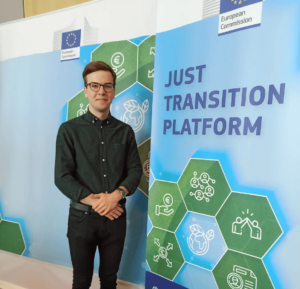
“When I see articles in the local media, like after the climate strike there are comments like: Well, you’re probably charging your phone on electricity, which is from coal and so on – I’ve just learned not to worry about those comments. I enjoy the fact that there are people who wish me well and write good comments.”
Money, naturally, is also an obstacle. There is not enough support for Piotr’s activities, because municipal grants are launched at the beginning of a year and one has to apply at the beginning of the year, because after that the money is gone. There is also no funding for climate lessons in schools. Hence, Piotr does all of his work related to these things without any funding at all.
When Piotr began his activism, the needs of young people were not taken care of and at an early meeting in 2019 of stakeholder groups, miners and local government officials, Piotr was the only young person who showed up.
“I was listening to these solutions, what they are proposing and there were only solutions related to energy and infrastructure. There were no social ones, let alone youth ones. I stood up at the meeting and said through the microphone: you’re going to have new roads on which there will be no one to drive, because everyone will leave.”
That was a sentence that shocked the people in this room. Since then, Piotr has often repeated those words, because they sum up the direction in which the region will develop if things do not change. After said meeting, there were a lot of working group meetings related to the Just Transition process, and there Piotr tried to talk about investments in people rather than infrastructure. So far, there have been four working groups: a working group on social issues, the environment, infrastructure, and energy. Piotr came up with the idea that there should be a youth group to focus more on developing demands, because once again he found himself as the only young person in the room and, as he points out, he is not omniscient and could not speak on behalf of all young people about what they really think is best. The body that is leading this process, the Regional Development Agency, agreed to set up such a working group.
“We got together a group of people from schools and from the local university for a workshop that was held in October 2020 and at that workshop we came up with 23 ideas for youth solutions that we felt should be in a Just Transition. Then there was a moment where there was a consultation of this plan and we tried to push as many solutions as possible into this plan. In fact, some of it was successful. We managed to work out the support of young people into the labour market, the issues of additional education classes. Not all of it that we wanted, but at least some of it.”
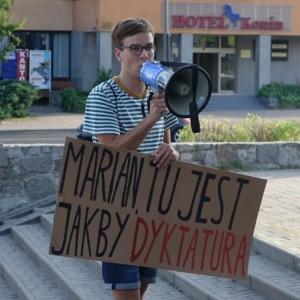 The group was also successful in introducing solutions that are not strictly youth-oriented, but also affect young people, such as the development of public transport. It is mainly young people who commute to school or to work by bus. There were also quite a few solutions that this group cared about that were not youth-oriented at all, and in fact, most of them were implemented. They brought up the issue of business incubation, or the issue of water restoration, or reclamation of post-mining areas. Furthermore, a solution related to financing youth initiatives, i.e., a kind of youth grant, has also successfully been passed.
The group was also successful in introducing solutions that are not strictly youth-oriented, but also affect young people, such as the development of public transport. It is mainly young people who commute to school or to work by bus. There were also quite a few solutions that this group cared about that were not youth-oriented at all, and in fact, most of them were implemented. They brought up the issue of business incubation, or the issue of water restoration, or reclamation of post-mining areas. Furthermore, a solution related to financing youth initiatives, i.e., a kind of youth grant, has also successfully been passed.
“Our role now is to ensure that the solutions that were important to us and were not included should be implemented in other fields, on other programmes. We need to pay attention to how they will be implemented and when they will be implemented, whether it will be what we thought, or whether again the decision-makers will say that they will implement it in their way, which will be a completely different way, and then monitoring if these solutions are implemented. Monitoring whether the solutions are actually delivering the results we have identified, or whether something more is needed.”
There are many challenges ahead for Piotr with this action plan. First and foremost, he wants to develop his association so that it can raise more funds for its activities. He also certainly wants to focus on informing the locals about what is happening in the region. The reason for this is that a lot of people, including young people, don’t know what a Just Transition is, where the region is going and what direction it’s all going in.
And although it involves effort, Piotr stresses: “I just like what I do and nobody really pays me for the things I do. For activism or political action. If someone is doing something they don’t enjoy, then they might put it off. And I’m motivated to pin things down until the end.”
Spread the word about the EUTeens4Green project that offers up to €10 000 for local youth-led projects!
Emilia is a 17 years-old activist and climate educator from Poland. In the following article, she talks about her experience with teaching kids about the climate crisis and why she thinks that politicians stand in the way of change.
My name is Emilia, I am 17 years old, and I live in a rural area of Poland, near the city of Toruń. I hope to be a doctor one day, but now my passion is climate education.
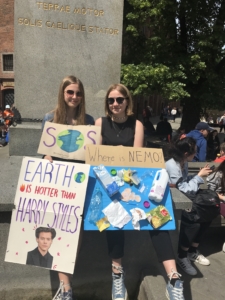
Emilia at her first protest
I first learned about climate strikes when I was 14. I went to my first strike near our city council with my friend. Nobody else showed up, so we were the only ones there. Somebody called the security staff on us – we were absolutely oblivious to the rules you need to follow to be legally allowed to strike. But we did not leave. Instead, we climbed on a statue and sat there with our posters. People passing by saw us, started taking pictures and talked to us. It was such an amazing experience that I decided to be a climate activist.
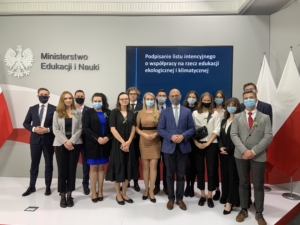
Emilia at the Ministry of Education
Then I joined our local Fridays for Future chapter, but it was not very active, so we needed to organise strikes with my friends. Last year, I joined a FFF’s international project concerning climate education. Since then, I have been teaching classes about the climate. I and my colleagues have also been meeting with the Polish Ministry of climate and the Ministry of education. We try to convince them that we need climate education in Polish schools. It looks promising.
However, there are a lot of barriers to change. The biggest obstacle is not the law but the politicians who are unwilling to change anything. Like when I met the Polish president Andrzej Duda at one of his rallies in 2020. I went there with a banner saying simply: And what about the climate? He noticed and went over to talk to me. I tried to explain to him the severity of the climate crisis, but he said people are not willing to change. I do not believe that. Everybody wants to live a healthy life. If they were explained how serious the situation is, they would be willing to make changes. This is just a politician’s excuse.
Not only influencing politicians to do something is a struggle. Also the complete lack of information among the general public.
We need to teach these things at school. I had just one lesson about climate change last year during geography. The only takeaway from the lesson was that scientists are unsure if climate change is happening. It is ridiculous to teach that at school.
Still, I do not believe that the climate crisis is only about the environment. Social issues are connected with it. We try to cooperate with a local LGBTQI+ centre and organisations that focus on women’s rights in my local area. Whenever we have a strike, we invite them to give a speech, because we are in this together. This is one fight.
Seeing that what I am doing has an impact on people is what really keeps me going. It is just beautiful to see kids as young as 6 years old
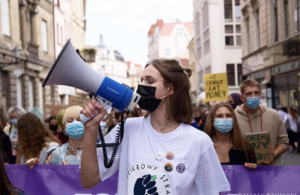
Emilia Rygielska at a climate protest
be eager to make a difference in the world. I would like to think that they also tell their parents what they learn in our classes, and their parents to their friends, and then more people find out about the dangers of the climate crisis and maybe join us. I would like to see more older people joining in the fight.
I think the older generation does not fight for it because they are unaware. I have heard people saying that the climate crisis is not real. Other people say it is real, but it does not affect them, because they are 50 years old. Although, there have been some elderly people at the climate strikes, which is always so nice to see.
A group of people my parents’ age in my local area fights against cutting down a local forest to make space for industrial buildings. They took action because it would have a direct impact on their lives. So, I think the indifference is just a matter of older people thinking that the climate crisis is not their problem. Because my generation already knows that it is our problem.
Most of us found out about the climate crisis through social media, and we felt like it directly concerns us. That is the reason why we fight for change. There are always things we can change, regardless of where we live. Even if we are alone at first, we find people along the way.
Activists uplift each other. When I look back, I am really amazed by what we achieved in one year. So, start now! Just make sure to know the laws not to get in trouble, because if you are in trouble you cannot do anything.
Social media on environmental issues can sometimes be the only source of knowledge for young Poles. Ola Czajkowska, a 26-year-old resident of Warsaw, has taken matters into her own hands. Professionally involved in marketing, and thanks to her maternity leave she has developed social media channels where she shows simple solutions to inspire other Poles to take action in their own lives.

Ola Czajkowska, a 26-year-old activist
Ola first came across the concept of zero waste approximately four years ago. And since then, she has been trying to implement eco solutions in her life. Since last year, she has been active on social media, including TikTok. Running social media on this topic allowed her to grow personally, to learn new things – by preparing content, she learns something new all the time.
“What touched me the most is that we are inundated with plastic from everywhere. It’s in the oceans, it’s on pavements, it’s in the stomachs of animals that people eat, and it’s even been detected in human blood! Everything in the shops is packaged in plastic. I realised that not using plastic isn’t that hard at all and I can do it here and now. And that’s how it started.”
Ola’s activism particularly focuses on zero waste, environmental protection and vegetarianism. As she points out, these three topics come hand in hand. Zero waste is a way of living without waste, with respect for the environment – we don’t generate rubbish, we use what we have, we make sure that the products we already have are recycled.
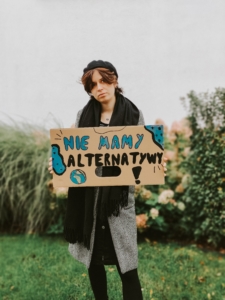
Ola Czajkowska at a strike
So is reducing meat consumption, because meat production is one of the main drivers of climate change. Ola is trying to tell people that it all comes together, like one big package: there are no isolated solutions to singular problems – they are all interconnected and can thus be tackled holistically.
Ola also mentioned that being vegan doesn’t have to be difficult, especially as we have more and more vegan restaurants and animal product substitutes in the shops.
“Many people say that being eco is expensive. Because they just imagine that if you are vegan you have to eat only vegan meat alternatives. That if you want to be eco, you have to buy metal straws, an expensive water bottle or ‘eco’ cleaning products. I also show these solutions, because they can make life easier in some situations. But at the same time, I want to encourage us to use the simple ways that our mothers or grandmothers remember. A nutritious vegan dinner can be made from legumes or porridge, and cleaning products can be made from products we find at home – baking soda or vinegar, for example.”
One of the channels on which Ola is actively involved is TikTok. In Poland, environmental education is at a very low level, in schools kids are hardly taught about climate change, its influences and how it can be prevented. Ola thus wanted to start reaching out on TikTok to precisely these younger people: school-age kids, and to teach them about ecology in a simple, accessible way.
And indeed, Ola sees that she has encouraged many young people to make eco changes in their lives, as well as encouraging other people to adopt eco-friendly habits.
“I started my first blog in 2004, when I was in primary school. Now blogs are more like portals than diaries. But also, a lot of people have moved away from blogging and moved to social media platforms, where you can run everything from your smartphone. I’m happy about the popularity of social media, because you can easily reach a huge amount of people, including with such environmental or scientific messages.”
Ola thinks her goal is a good future of the planet. Unfortunately, many people ignore climate change and our planet is in a worse and worse state. She would like everyone to take steps towards caring for the planet. It could be cutting down on meat consumption, it could be picking up litter while walking or getting involved as a volunteer in an environmental organisation – small steps that can have large impact.
“I would like to be able to enjoy what’s around me in these 30 years, to have a peaceful life and not have to fight for drinking water or food for my family. I hope that in the next few years I will still have the resources to act as much as I do now, or even more!”

Ola Czajkowska at Pride parade
One of the biggest challenges she faces as an activist in Poland is certainly that society needs to change its attitude towards ecology. People need to be educated, to make eco changes in their lives, and at the same time fight for systemic changes to happen, for them to vote in elections for parties that advocate fighting climate change as a priority and for politicians to finally make some decisions involving those issues.
In addition to her environmental activism, Ola has also been a proud ally of LGBTQ+ people in Poland for years. As she points out, just talking about it, declaring herself an ally, adding her pronouns in her bio profile – this is already part of that activism, once again highlighting how small steps can add up to make a big difference.
Despite the environmental themes of her channels, Ola tries to share initiatives in support of LGBTQ+ like petitions or donations. She also actively participates in pride parades every year.
Ola believes that what we can do here and now is to give up eating meat, not using a car as a main means of transportation, as well as reducing fast fashion and introducing real packaging recycling everywhere. These are things that we don’t have to wait for to be implemented systemically, and we can contribute as individuals – by going vegan, not buying new clothes, recycling or buying products without packaging.
“I encourage you to make at least one small eco change in your life. And then, in small steps, it will go from there! And don’t be discouraged if you slip up!”
Author: Emma Pagliarusco During the past year, we have talked a lot about the three pillars of the Aarhus Convention: the rights of public participation, access to information and access to justice in environmental matters. We have written handbooks and articles; as well as organized workshops to raise awareness and build capacity among young people on these procedural rights that usually remain in the shadows. As the Aarhus Convention is a key instrument within the UNECE region and beyond to promote, protect and fulfil the right to actively participate in environmental decision-making, YEE is constantly at the frontline in ensuring that decisions take into consideration the interests of youth. This also consists of attending the Aarhus-related processes, composed mainly of the Meeting of the Parties (MoP) and the Working Group of the Parties (WGP). Attending these meetings is crucial to influence decision-making, raise awareness and advocate for our interests. In October, we attended the MoP, where our advocacy coordinator Pegah and project lead Laura delivered statements raising the need for youth organizations to receive more funding and denouncing the European Union’s failure to comply with the Aarhus Convention. Read more about this in our handbook. From 22 to 24 June, Clara Botto, Environmental Governance Liaison Officer, and I also participated in the WGP and exMoP, where we strengthened our role there and youth participation more broadly. The meetings took place at the UN headquarters in Geneva, consisting of the 26th WGP and the ExMoP3 devoted to appointing a Special Rapporteur on Environmental Defenders (a historical moment!). For months before, the YEE Environmental Law team had followed the preparation behind, in coordination with other NGOs (in particular with the European Environmental Bureau) which are part of the ECO Forum network (the name under which NGOs were sitting in the room). From the 22 to the first half of the 23 June we attended the 26th WGP, which this year included two thematic sessions on access to information and on promoting the application of the principles of the Convention in international forums. In coordination with other NGOs, we managed to secure a keynote statement on the thematic session on access to information (item 3a in the agenda). The discussion focused on the means for advancing public access to environment-related product information: for example, the role of digitalization; the threat of greenwashing claims and the role of product passports were largely discussed by representatives of states. On behalf of YEE and Eco Forum, we stressed the universal character of the right to access information, the promotion of which has to be carried on also among the youngest generations. As a matter of fact, accessing environmental-related information is also an essential precondition for exercising the right to live in a clean, healthy and sustainable environment. We then recognized that means such as product passports can substantially help young people in accessing product information; as well as strongly reduce the risk of them being subject to greenwashing, making them particularly receptive to green claims. Representatives from states shared the good practices implemented at the national level. We also delivered a statement on the Capacity Building and Awareness Raising item (4c in the agenda). Here, Clara stressed the role of youth organizations in building capacity and raising awareness, but also the need to secure more funding for them, YEE being the only youth-led organization present at the meeting. She also underlined the urgent need to promote education on sustainable development matters for contrasting the current and future climate crises. Right after the WGP, thus from the second half of the 23 to the 24 June, we attended the third extraordinary session of the Meeting of the Parties (ExMoP3), which was something historical. Generally, extraordinary sessions of the MoP are held if there is some urgent matter to be discussed or a big decision to be taken. During this one, a Round Table on Environmental Defenders was held, during which environmental defenders, Parties to the Aarhus Convention and NGOs engaged in a discussion on the main trends, challenges and good practices with regard to the protection of environmental defenders in the region and beyond. The discussion was followed by the appointment of the first special rapporteur on environmental defenders in the world: Mr Michel Forst was appointed with unanimity by the parties. The Special Rapporteur’s task is to “protect any person experiencing or at imminent threat of penalization, persecution, or harassment for seeking to exercise their rights under the Aarhus Convention”. The urgency to build a strong framework of protection was exacerbated by the fact that right when we were having the meetings, Brazilian indigenous expert Bruno Pereira and British journalist Dom Philips were found dead after weeks of search in the Brazilian Amazon forest: they were killed some weeks before while they were denouncing illegal fishing, mining, logging and drug-trafficking activities in the forest. Clara raised the issue in the room with a statement, paying homage to their families. We from YEE recognize that the parties have to take joint action to immediately stop these facts. After Mr Forst’s election, we also had a meeting with him together with the other NGOs from ECO Forum to discuss the priorities for his mandate. We raised the particular vulnerability of young environmental defenders in the UNECE region. The outcomes and the way forward The outcomes of the meetings can be found here. You can find our position reflected in point 3(a) par.ii and vi. As a way forward, we will continue pressing for securing funding for youth organizations as a priority for ensuring that youth representatives can participate in these meetings and ensure their position is respected. Additionally, programs of awareness raising and capacity building have to be put in place to inform young people of their rights and opportunities to participate and enforce the rights of the Convention, according to us. Within YEE, if on the one side for the upcoming year we will continue to follow the first line of the Aarhus-related processes; on the other we will strengthen capacity-building and awareness-raising activities through explainers and interactive workshops. One of the main hurdles we face is that the principles protected from the Aarhus Convention, being mostly procedural in nature, are sometimes disregarded and detached from the youth-inclusion rationale. However, especially at this moment in history, with the UN recognition of the right to a clean, healthy and sustainable environment, we cannot conceive of procedural rights as detached from the substantial ones: being in the frontline is necessary to ensure intergenerational justice, human rights and environmental protectionAarhus Diary – 26th WGP & ExMoP3, 22-24 June 2022
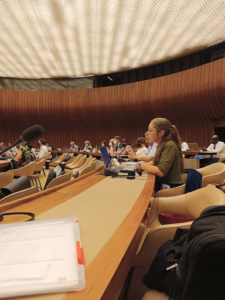
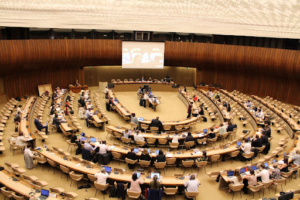
The 26th WGP
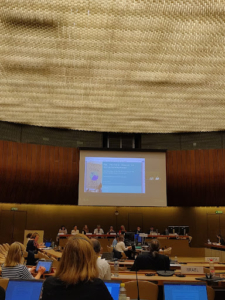
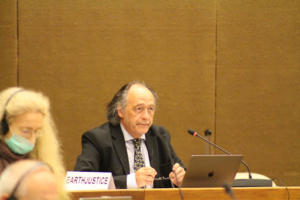
The ExMoP3
Climate change is one of the most fundamental problems of humanity and international climate negotiations and lawsuits against governments and companies for their climate policies are taking place more frequently than ever. But are we able to follow them? As knowledge is power, our environmental law team is hosting a series of 4 workshops during June and July to empower young people to become more involved in the international and European climate regime and provide them with the knowledge needed and bring them in contact with experts working on the field. The workshops will cover topics of fundamental international environmental law, public participation & environmental impact assessment as well as different angles of climate litigation and its current developments. Certificates will be given to the participants who attend 75% of the workshops (minimum 3 out of 4). We aim to build capacity on the basic knowledge of international environmental law and include young people with no legal background in the climate movement. Through our 3rd workshop, we aim to provide a better understanding of public climate litigation having as guest speaker Filippo Fantozzi, Legal Associate in the Climate Litigation Network of Urgenda. Urgenda is one of the most widely discussed climate litigation cases against States. Through this workshop, participants will learn more about climate lawsuits against public actors from an expert, who is involved in one of the most influential cases of the climate litigation movement. The 3rd workshop is going to take place online on the 4th of July at 16.30. When?4th of July at 16.30 CET Where? Online, from your home via Zoom – the link will be communicated upon registration How? Register your interest by 1st July [12 noon CET]. Trends in Climate litigation
What you can expect
Practical information
Author: Anna Marino One of the first lessons I learned when I first approached the field of ocean advocacy at YEE (and joined the Youth4Ocean Forum), is that you do not need to live by the ocean to be (and feel) connected to it and to do something to protect it. When you grow up in a coastal town as I did, you take that feeling for granted. Some of those principles that are now embedded in the concept and practice of “Ocean Literacy”, were already standard ideas in my daily life. It’s as simple as that. Later on, I realised that the opposite can be true as well: when it comes to polluting and exploiting the ocean, humans are historically convinced that it could be treated as an inexhaustible resource. Anna at EMD & the EU4Ocean Ocean Literacy Summit On the contrary, the ocean is more and more under pressure on multiple levels, with devastating feedback effects on the environment and climate. Without the ocean (yes, there is only one big ocean on this Earth), the environment and climate as we know them today would cease to exist: the ocean is the Planet’s main climate regulator, constitutes over 95% of the biosphere and ensures subsistence to more than 3 billion people. But how do we communicate the importance of the living ocean in everyone’s life, to choose more sustainable behaviour, while supporting system change? This is where ocean literacy enters the scene and what I wish to talk about on this World Ocean Day, by telling you more about my experience at the EU4Ocean Ocean Literacy Summit! Ocean literacy is what brings the EU4Ocean Coalition together. We are three communities (the EU4Ocean Platform, the Youth4Ocean Forum and the Network of European Blue Schools) working towards one important goal: spreading ocean literacy around all of Europe, connecting people to the ocean, and driving action to protect the ocean. What I think is truly inspiring about the Coalition is that it brings together people of all ocean-related fields and ages, to collaborate on the creation of meaningful ocean literacy tools and actions. From educators, youth workers and students, to advocacy experts, marine biologists and scientists, artists, and explorers… everyone contributes to this big wave in their own way. I consider the EU4Ocean Ocean Literacy Summit in Ravenna as an eye-opening experience in which I discovered some of the incredible work and achievements that people, organisations, and communities have realised under this project in the past 2.5 years – a little “universe” of meaningful ocean actions that sometimes do not always reach the wider public. The EU4Ocean Summit was hosted by the European Commission’s (DG MARE) annual conference, European Maritime Day (EMD), in Ravenna. EMD is the annual occasion for EU maritime stakeholders to come together to network, touch base on the state of EU maritime affairs, and find ways to cooperate and move forward. The second day of this conference was entirely dedicated to the EU4Ocean Summit, to discuss ocean literacy in the context of three thematic areas (Ocean and Climate, Food from the Ocean, and Healthy and Clean Oceans), and to celebrate the winning projects of the Ocean in action! Awards, and look at the future of this Coalition by bringing all its communities together in an in-person event for the first time. Youth and Capacity building for Ocean Literacy – Connecting generations through storytelling. This workshop was an attempt to bring different generations together in a youth-led session, this hybrid workshop showcased storytelling as a powerful ocean literacy tool. Participants were directly involved in the delivery of storytelling by exchanging personal stories about the living ocean and their connection with the ocean, based on the storytelling method to convey a powerful message that could leverage on the listener’s emotional connection to the ocean. As a co-moderator of this workshop (and Youth4Ocean Forum member), I can confirm that we had a lot of fun preparing the event as well as carrying it out! Participants were very active and were positively surprised by how much they could share and connect with other people (of every age) in the room. If you dream of becoming a storytelling expert, or you’d just like to know more, the recording is now available on the EMD website! Anna meeting Commissioner Sinkevicius. It’s 9 am in the morning, a perfect time for a coffee break with Commissioner for the Environment, Oceans and Fisheries, Virginijus Sinkevicius! During this youth dialogue, several members of the Youth4Ocean Forum shared their stories and introduced their ocean literacy projects, and invited the Commissioner to share his own personal ocean story, too. I appreciated how the Commissioner put an accent to the role that young people have and should be granted in international environmental decision-making, highlighting the importance for young ocean advocates like us to participate in all environmental processes, as they are all relevant for the ocean and thus they are important for the positive change we wish to see in ocean affairs. Achieving substantial results to protect biodiversity at COP15, he underlined, is a major priority. Although we ran short of time soon and the Commissioner was called to participate in the morning plenary session, he shared with us the hope to find other occasions for dialogue and exchange, only next time, in a roundtable rather than on stage with a small group of youth representatives. This was in my opinion the most creative, entertaining and educational space in the venue. Between informal talks with experts from different ocean-related fields, quizzes and games for children, exchanges with schools, the possibility to make a pledge for the ocean or to just sit back and relax while listening to the EU4Ocean podcast “If Oceans Could Speak”, I saw ocean literacy in action in multiple, innovative forms and got the chance to share my passion for the ocean with so many people of different age, professional fields and walks of life, bringing me to the important message that you do not need to be an ocean professional or know everything about the ocean, to be (and feel) connected to the ocean. Each and every one of us, at any time, can do something that helps the ocean! And in case you were wondering if we actually went to the sea… the answer is YES! I was lucky enough to be involved in immersive experience at Marina di Ravenna, with a beach cleanup with Youth4Ocean friends, local high school students and teachers from the Network of European Blue Schools, plasticfree, and researchers from the National Research Council (CNR) , followed by a visit at the CESTHA centre. There, I found out that they are the biggest sea turtle rescue centre in Italy, hosting nearly 50 lovely guests who are currently recovering from their injuries to later be released into the sea! Seeing how much love, research, and innovation go into these activities was really insightful and is an experience I wish every young ocean and environmental advocate could have. To discuss all forms of expressions of and notions on ocean literacy, I would need to write an entire book (until then, many resources are actually available online: you can start by discovering the 7 Ocean Literacy principles here!), but with this article that I tried to simply describe my experience of EU4Ocean and convey this important message: ocean literacy is key to communicate the importance of the ocean, spread knowledge about the living ocean, and drive action to protect our ocean, paving the way to more sustainable societies, economies, for a healthy and protected ocean future. The ocean is as important as it is seriously underprotected and largely unexplored (did you know that more than 80% of our ocean is unmapped, unobserved, and unexplored… meaning that we explored and mapped the Moon’s surface MORE than we explored the ocean?!). And while ocean biodiversity quickly degrades and the consequences of ocean pollution reach irreversible points – in the face of inadequate international protection – youth voices are still widely underrepresented.Underprotected & Underrepresented – Youth & Ocean issues in Europe
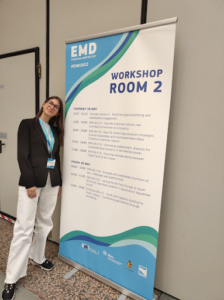
The EU4Ocean Coalition
My experience at EMD & the EU4Ocean Ocean Literacy Summit
I absolutely loved being part of one of this event’s workshops
We also had the youth dialogue with Commissioner Sinkevicius
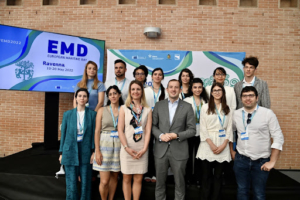
The EU4Ocean booth
Experience in the field
My final message to young people
What can we do, then?
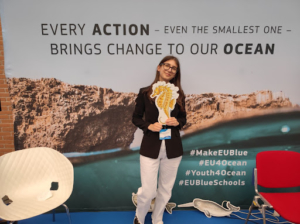 Let’s raise our voices for the Ocean in the run-up to the UN Ocean Conference in Lisbon! The Youth4Ocean Forum and YEE representatives will be there to advocate for stronger and more extensive protection of ocean life through international governance, spreading ocean literacy, and to push world leaders towards more meaningful engagement of youth in ocean-related decision-making, such as under the future High Seas Treaty. If you have a message you would like us to bring to UNOC, send me an email at anna@yeenet.eu …and don’t forget to follow YEE on social media to connect with us in Lisbon!
Let’s raise our voices for the Ocean in the run-up to the UN Ocean Conference in Lisbon! The Youth4Ocean Forum and YEE representatives will be there to advocate for stronger and more extensive protection of ocean life through international governance, spreading ocean literacy, and to push world leaders towards more meaningful engagement of youth in ocean-related decision-making, such as under the future High Seas Treaty. If you have a message you would like us to bring to UNOC, send me an email at anna@yeenet.eu …and don’t forget to follow YEE on social media to connect with us in Lisbon!